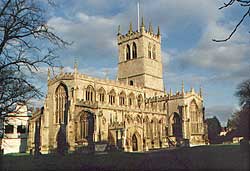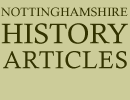CHAPTER XXVIII. RETFORD AND ITS RECORDS. [Continued]
"Also where the said burgesses have talked and agreed with one John de Carberton, hermit, to pave the said town of East Retford, partly for charity, and partly for his sustenance, to which pavement some of the said burgesses gave of their own proper soil to dig stone, gravel, and sand to be carried to the said pavement, in amendment of the said town, then the said Sir Thomas laying ambushes, sending many times archers with bows and bent arrows drawn, and other persons unknown, made assault on the said hermit at West Retford, and his cart with five horses took, led away, and impounded for a long time, until the said hermit found pledges to pay him two marks, wrongfully and against the law, and to the banishment of the said hermit and hindrance of the said pavement. And besides this the said Thomas hath done divers wrongs and injuries to divers particular persons, burgesses of the said town of East Retford, who would complain if they see time and place, &c.
"May it please our very honoured lord, the Chancellor, for [the love of] God, and in work of charity, and in preservation of the king's right, to ordain due and speedy remedy for the said burgesses for all the wrongs and oppressions aforesaid, so that they may be able to pay the king their farm of the said town, and to live in tranquility and peace as the liege tenants of the king and faithful and loyal subjects"(1).
We do not find any entry showing the result of the proceedings, but in 1424 there was a further Royal grant of privileges, and the establishment of a Court of Record for the relief of complaints. A Town Hall had been erected some years previously, and a stock-house made for stocks to be set under the steps of the hall. Perhaps the best summary of the Royal favours conferred on the borough is that given in the entry of the visitation of Sir Richard St. George, Norroy King of Arms in 1614, and preserved in the Harleian collection. After stating that King Edward granted the town with fee farm to the burgesses, it says, " Henry III. granted them a fayre; Edward III. exempted them from all tolls and foreign servisses; Henry VI. gave them a court of record with many other liberties. All which privileges have been from time to time confirmed by the several kings and queens of this land, and now, lastly, our gracious Sovereign Lord King James, in the fifth year of his reign, did not) only confirm all former grantes made by his predecessors, but also incorporated it anew by the name of the bayliffs and burgesses, and appointed the same to be governed by twobayliffs, and likewise twelve aldermen to make a Common Council for the town; also they shall have a common seale with power to alter it at their pleasure; and that the two bayliffs for the time being and the learned steward shall be justices of the peace and quorum within the said borough." The entry is signed by Nicholas Watson and Thomas Draper, bailiffs, and Robert Brown, town clerk.

St Swithun's church, East Retford (photo: Andrew Nicholson, 2001).
Thus steadily did Retford prosper, increasing in population and in influence from century to century. Its life seems to have been the ordinary life of a quiet country town, the even tenour of its way being uninterrupted by any great or stirring events that happened within its borders. It had contributed two eminent men at least to the service of the State, and we believe it had sent another, for in the records of Parliament we find that in 1404 Sir Henry de Retford was chosen Speaker of the House of Commons, and it was through his mouth that the Commons gave to the King their most humble thanks for his many valiant exploits. He was succeeded, in 1406, by Sir John Tibetot, who would also be, we presume, a Nottinghamshire man, for the Tibetots were the ancient lords of Langar, in this county (2). Meanwhile, the parish church of St. Swithin continued to be the principal building within the borough. When the first stones were laid of the sacred edifice, wherein so many generations of Retford people have worshipped, it is difficult to say, but it is certain that there was a church here in the twelfth century, if not in the eleventh. The earliest record is of its being given by Archbishop Roger to his newly founded Chapel of St. Mary and Holy Angels near the Minster of York. Now Archbishop Roger occupied the see from 1154 to 1181, and his endowment of the chapel was a very noble one. Eleven churches were appropriated to it, five of which; were purchased with his own funds (3). In 1258 Gilbert de Tyva was made sacrist of the Cathedral, and inducted into the possession of the Church by Archbishop Sewal de Buvil, the Bishop directing that the Vicar of Retford should have 100s. out of the altarage, and the small tithes, viz., of chickens, pigs, geese, and the bread and wine which should happen to be brought to the altar. In 1392 the bailiffs founded a chauntry, one altar being dedicated to the Holy Trinity and the other to St. Mary; and chauntry priests continued to officiate here until chauntries were abolished by Edward VI. The chapel was at the back of the chancel, but being in ruins was demolished and the church repaired with the old materials.
We come next to an interesting item about the church, in regard to which we are able to supplement the information hitherto given. In 1651, according to Mr. Piercy, the tower, the steeple, and a considerable portion of the rest of the church were blown down, and he quotes an entry from the minute book of the Corporation dated November 4th, 1652, describing the disaster, and stating that the inhabitants being unable to rebuild what had fallen, and failing to procure the assistance of neighbouring towns, the Council had resolved to raise money by selling in fee farm the Corporation estate in Kirton, Willoughby, and Walesby. Mr. Piercy adds that the total cost amounted to £1,500, of which the greatest portion was paid by the Corporation, and that the work was finished in 1658. It was usual in those days for collections to be made in churches throughout the country to repair any great disaster, and in trying to ascertain if help was extended to Retford we find the following entry in the State Papers, which will throw some additional light on what took place in connection with this remarkable event. " June 3rd, 1658. Order on the petition of the bailiffs and burgesses of East Retford, and certificate of the Justices of the Peace of Notts., of 21st Jan., 1651, showing that the steeple of the only church there was blown down by a great wind 11th January, 1657-8 (sic), that the cost of repairing it will be £3,400, with which repair they have made considerable progress, selling their lands and contracting debts to pay for the same, and desiring letters patent to collect money for the purpose in Notts, Lincoln, York, and the City of London" (4). The petition was acceded to, and the brief renewed in March, 1658. We have not space to say more of the church—which is a very interesting edifice, aud contains many mural monuments in the transepts —than that it was thoroughly restored in 1855, and that some valuable gifts and additions have been made to it since that date.
In the troublous events which arose in the reign of Charles I., Retford took little part. It was assessed to ship money in 1635-6 at only £30, whereas Newark had to pay £120, and complaint was made that it was let off so easily. When the war prevailed the town was several times visited by bodies of troops, and the King passed through on his way to Doncaster, but it was never the scene of any great turmoil or bloodshed. There are several entries in the State Papers relating to the town during the Stuart period which may not be uninteresting. The Commissioners of Musters were in the habit of holding musters at Retford. In 1622 they reported to the Council that they had held a muster and found all in good condition, ready for instant service, and to suppress riots if required. There was a good provision of powder and bullet, and the state of the beacon was satisfactory. In 1625 a licence was granted to John Watson, of Retford, and his wife to keep a tavern and sell whiskey at such prices as they pleased, certain statutes notwithstanding, upon payment to the king of £3 per annum. At the Retford sessions in 1630 the justices reported to the Council that they had taken the recognisances of John Molanus and three other workmen of Sir Cornelius Vermuyden, the complaint being that while digging in a field of Sir Francis Thornhill the men had struck Edward Thornhill and used indecent words against Sir Francis. Sir Cornelius Vermuyden was a famous Dutch engineer, and the Cars were drained by Dutch and Flemish workmen under his supervision.
In 1745, on the occasion of the rebellion under the young Pretender, an army of 6,000 English and Hessian troops encamped upon Wheatley Hills, and the soldiers on marching through Retford made a stable of the church for their horses. The members for Retford at this period were John White and William Mellish, and in connection with their return in 1741 the following curious story is told:—
"Mr. Mellish resided at Blyth, and in early life was betrothed to a Jewess of considerable property, but which, by a curious clause in the will of her father, her husband could not inherit until chosen member of Parliament. Accordingly he offered himself for Retford, and as a matter of course was anxious to succeed in his endeavours. On the morning the election took place he brought two different coloured horses to Retford, the one grey, the other bay, by means of which he was to send information of the result. If chosen the grey one, if not the other. There being no opposition he was elected, and immediately despatched a messenger on the grey horse. His lady, anxious for the success of her lord, was keeping a sharp look out for the signal, on disco veriner which she was so overjoyed that she fell into hysterics, and in the course of two or three days actually died from the effect."
In 1826, after an exciting contest, the members returned in that year were unseated on petition, and it was resolved that the corrupt state of the borough required the serious attention of the House. Protracted debates and divisions ensued, but eventually in 1830 the franchise was extended to the hundred of Bassetlaw, of which Retford has since formed the centre.
Such briefly told are some of the leading incidents in the history of the borough. Its records are not eventful, but they are by no means devoid of interest and value. There is no doubt much to be gleaned about the locality which has not yet seen the light, and it is to be hoped that ere long some industrious antiquary will undertake the task of collecting it. Mr. Piercy deserves to be held in grateful remembrance for his useful little book, but the history of Retford remains to be written
(1) Proceedings in Chancery, I., xix.
(2) Parliamentary History, ii, 70.
(3) Fasti Eboracensi 248.
(4) State Papers (Domestic), 1653-9.
